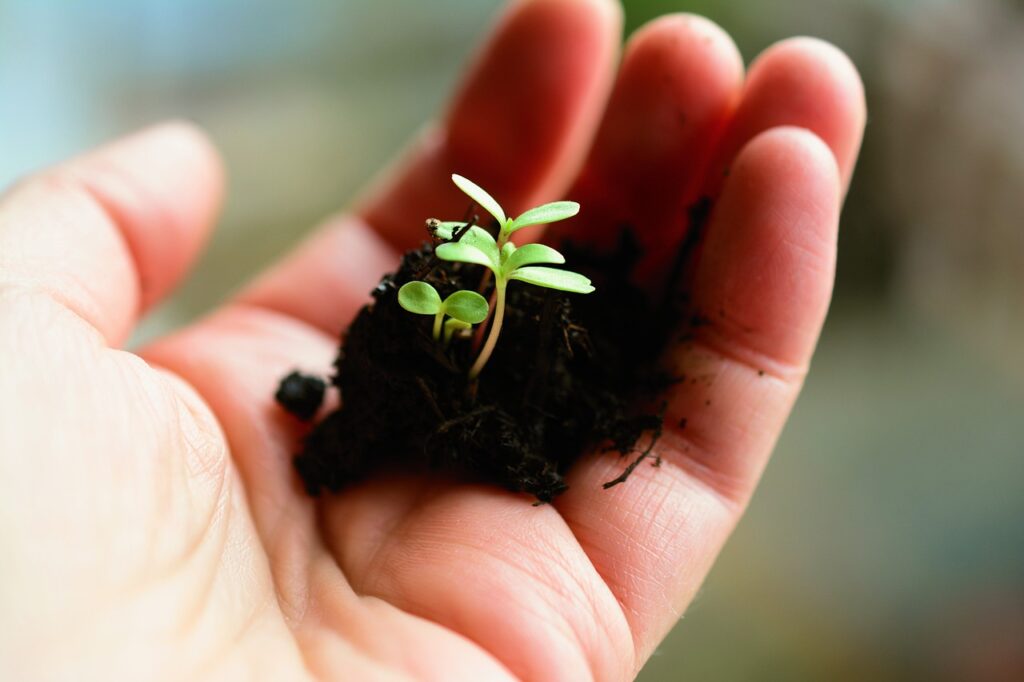Cultivate Good Soil and a Growth Mindset: A Guide to Effective Leadership
The Importance of Mindset and Soil Quality in Leadership Development
Leadership development is a complex and ongoing process that requires constant attention and effort. One key factor that can make or break a leader’s success is their mindset. Your mindset shapes the way you approach challenges, how you make decisions, and how you interact with others.
In this article, we’ll explore the importance of mindset in leadership development and how it relates to the concept of “good seeds won’t grow in bad soil.” We’ll discuss the impact of mindset on leadership, the importance of having a growth mindset, and how mindset affects the quality of the soil in which good seeds can grow.
We’ll also look at strategies for improving both mindset and soil quality, including self-reflection, building a positive support network, and investing in personal development. By the end of this article, you’ll have a better understanding of how to cultivate a healthy mindset and soil quality to support your ongoing leadership development.
Importance of Mindset in Leadership Development
Your mindset refers to your beliefs, attitudes, and assumptions about yourself, others, and the world around you. These beliefs can be either positive or negative, and they can greatly influence the way you approach leadership challenges.
For example, a leader with a fixed mindset believes that their abilities and traits are fixed and cannot be changed. They may see challenges as threats to their identity and may be more likely to give up when faced with obstacles. On the other hand, a leader with a growth mindset believes that their abilities and traits can be developed through hard work and perseverance. They may see challenges as opportunities for growth and may be more likely to persist in the face of adversity.
Research has shown that leaders with a growth mindset are more likely to be successful in their roles than those with a fixed mindset. They are more adaptable, resilient, and better able to navigate change and uncertainty. They also tend to be more open to feedback and willing to learn from their mistakes.
Concept of “Good Seeds Won’t Grow in Bad Soil”
The phrase “good seeds won’t grow in bad soil” refers to the idea that even the best ideas or intentions won’t succeed if they’re not planted in fertile ground. In the context of leadership development, this means that even the most skilled and talented leaders won’t thrive if their mindset and environment are not conducive to growth.
Just as a plant needs good soil, water, and sunlight to grow, a leader needs a positive mindset, supportive environment, and access to resources to reach their full potential. A leader with a negative mindset or toxic environment may struggle to develop the skills and attributes needed to succeed in their role.
In the next sections, we’ll explore the relationship between mindset and leadership, the importance of soil quality in leadership, and the interdependence of mindset and soil quality. We’ll then look at strategies for improving both mindset and soil quality, including self-reflection, building a positive support network, and investing in personal development. Finally, we’ll summarize our key points and emphasize the importance of continually working on mindset and soil quality to support ongoing leadership growth.
Relationship between Mindset and Leadership
Mindset Definition and Types
As previously mentioned, mindset refers to the collection of beliefs, attitudes, and assumptions that shape how a person thinks, feels, and behaves. The concept of mindset has been extensively studied by psychologists, and there are several different types of mindsets that have been identified.
One of the most well-known distinctions is the difference between a fixed mindset and a growth mindset, which was first introduced by psychologist Carol Dweck. People with a fixed mindset believe that their abilities and traits are predetermined and cannot be changed, while those with a growth mindset believe that they can develop and improve through effort and perseverance.
Other types of mindsets include a scarcity mindset, which focuses on what is lacking and limits possibilities, and an abundance mindset, which sees opportunities and possibilities everywhere. There is also a resilient mindset, which allows a person to bounce back from adversity, and an innovative mindset, which fosters creativity and problem-solving.
Impact of Mindset on Leadership
Leaders with a growth mindset tend to be more effective than those with a fixed mindset because they are more adaptable, open-minded, and willing to learn. They view challenges and failures as opportunities for growth and improvement, rather than as threats to their identity or competence.
In contrast, leaders with a fixed mindset may struggle to adapt to change, be less willing to take risks, and may not learn from their mistakes. This can limit their ability to grow and develop as leaders and may even hinder the growth and development of their teams.
Importance of Having a Growth Mindset in Leadership
Cultivating a growth mindset is essential for leadership development because it enables leaders to see challenges and setbacks as opportunities for growth and learning. A growth mindset encourages leaders to embrace new experiences and take on challenges, rather than shying away from them.
By adopting a growth mindset, leaders are more likely to be open to feedback, learn from their mistakes, and continuously improve. They are also better able to adapt to changing circumstances and are more resilient in the face of challenges.
Leaders can develop a growth mindset by reframing their thinking and focusing on the potential for growth and development, rather than on limitations and failures. They can also seek out new experiences, challenges, and opportunities for learning to expand their skills and knowledge.
Mindset plays a crucial role in leadership development. By cultivating a growth mindset, leaders can improve their adaptability, resilience, and ability to learn and grow. In the next section, we’ll explore the importance of soil quality in leadership development and how it relates to mindset.
The Importance of Soil Quality in Leadership
Soil Quality Definition and Types
In the context of leadership development, soil quality refers to the environment in which a leader operates. This environment includes the organizational culture, relationships with team members and stakeholders, access to resources and support, and the level of autonomy and decision-making authority.
Just as different types of soil can be more or less conducive to plant growth, different types of environments can be more or less conducive to leadership growth. For example, a toxic work environment with high levels of stress, conflict, and distrust can hinder a leader’s ability to develop and grow, while a supportive and positive work environment can foster growth and development.
Impact of Soil Quality on Leadership
Soil quality can have a significant impact on a leader’s ability to succeed and grow in their role. Leaders operating in a negative or toxic environment may experience higher levels of stress, burnout, and job dissatisfaction. They may also be less able to focus on their goals and priorities and may have difficulty engaging and motivating their team members.
In contrast, leaders operating in a positive and supportive environment may experience higher levels of job satisfaction, engagement, and productivity. They may also have greater autonomy and decision-making authority, which can foster creativity and innovation.
Importance of Having Good Soil Quality for Leadership Growth
Having good soil quality is essential for leadership growth and development. Leaders operating in a positive and supportive environment are more likely to be able to focus on their goals and priorities, develop their skills and knowledge, and engage and motivate their team members.
Leaders can improve the quality of their soil by building positive relationships with team members and stakeholders, fostering a positive and supportive organizational culture, and advocating for resources and support. By cultivating a positive and supportive environment, leaders can create a foundation for growth and development that can benefit both themselves and their team members.
Soil quality plays a crucial role in leadership development. Leaders operating in a positive and supportive environment are more likely to be able to focus on their goals and priorities, develop their skills and knowledge, and engage and motivate their team members. In the next section, we’ll explore the relationship between mindset and soil quality and how they interconnect to impact leadership growth.
Relationship between Mindset and Soil Quality
Interdependence of Mindset and Soil Quality
Mindset and soil quality are closely interconnected and have a reciprocal relationship. A leader’s mindset can impact the quality of the soil in which they operate, while the quality of the soil can also impact a leader’s mindset.
For example, a leader with a growth mindset may be more likely to seek out and create a positive and supportive work environment, which can improve the quality of the soil in which they operate. In turn, a positive and supportive environment can reinforce a leader’s growth mindset, providing them with the resources and support they need to continue to learn and develop.
On the other hand, a leader with a fixed mindset may be more likely to operate in a negative or toxic environment, which can limit their ability to learn and grow. A negative environment can reinforce a fixed mindset, making it more difficult for a leader to adapt to changing circumstances or learn from their mistakes.
How Mindset Affects Soil Quality
A leader’s mindset can have a significant impact on the quality of the soil in which they operate. For example, a leader with a growth mindset may be more likely to foster a positive and supportive work environment by encouraging teamwork, providing opportunities for learning and development, and promoting a culture of innovation and creativity.
In contrast, a leader with a fixed mindset may be more likely to foster a negative or toxic work environment by focusing on blame, criticism, and punishment. This can lead to low morale, high turnover, and decreased productivity.
How Soil Quality Affects Mindset
The quality of the soil in which a leader operates can also impact their mindset. For example, a positive and supportive work environment can reinforce a growth mindset by providing opportunities for learning and development, encouraging innovation and creativity, and fostering a sense of purpose and fulfillment.
On the other hand, a negative or toxic work environment can reinforce a fixed mindset by promoting blame, criticism, and punishment, limiting opportunities for growth and development, and fostering a sense of stress and anxiety.
Leaders can improve the quality of the soil in which they operate by promoting a positive and supportive work environment, fostering positive relationships with team members and stakeholders, advocating for resources and support, and creating opportunities for learning and development.
Mindset and soil quality are closely interconnected and have a reciprocal relationship. A leader’s mindset can impact the quality of the soil in which they operate, while the quality of the soil can also impact a leader’s mindset. By cultivating a growth mindset and fostering a positive and supportive work environment, leaders can create a foundation for growth and development that can benefit both themselves and their team members.
Strategies for Improving Mindset
Self-Reflection and Self-Awareness
One of the first steps in improving mindset is developing self-awareness. Leaders can use self-reflection techniques, such as journaling or meditation, to become more aware of their thoughts, emotions, and behaviors. By reflecting on their experiences and reactions, leaders can identify patterns and beliefs that may be limiting their growth and development.
Developing a Growth Mindset
Developing a growth mindset involves reframing one’s thinking to focus on the potential for growth and development, rather than on limitations and failures. Leaders can do this by seeking out new experiences and challenges, embracing failure as an opportunity for learning, and setting goals that stretch their abilities.
Cultivating Positive Self-Talk
The way leaders talk to themselves can also impact their mindset. Cultivating positive self-talk involves consciously choosing to use language that is encouraging and supportive, rather than negative and critical. Leaders can practice positive self-talk by reframing negative thoughts and using affirmations to reinforce positive beliefs.
Seeking Feedback and Embracing Criticism
Leaders can also improve their mindset by seeking feedback from others and embracing criticism as an opportunity for growth. By actively seeking out feedback, leaders can gain new perspectives and identify areas for improvement. It’s important for leaders to approach criticism with an open mind and a growth mindset, seeing it as an opportunity to learn and develop.
Practicing Mindfulness and Meditation
Finally, leaders can improve their mindset by practicing mindfulness and meditation. Mindfulness involves being fully present and aware of the present moment, without judgment or distraction. Meditation involves focusing the mind on a particular object or thought, often with the goal of achieving a state of calm and clarity. These practices can help leaders develop greater self-awareness, reduce stress and anxiety, and improve focus and decision-making.
Improving mindset is a critical component of leadership development. By cultivating self-awareness, developing a growth mindset, practicing positive self-talk, seeking feedback and criticism, and practicing mindfulness and meditation, leaders can create a foundation for growth and development that can benefit both themselves and their team members.
Strategies for Improving Soil Quality
Identifying and Addressing Negative Influences
One of the first steps in improving soil quality is identifying and addressing negative influences. Leaders can take a closer look at the sources of stress, conflict, and toxicity in their work environment and take steps to address them. This may involve having difficult conversations with team members or stakeholders, setting boundaries, or making changes to policies and procedures.
Building a Positive Support Network
Another way to improve soil quality is by building a positive support network. Leaders can seek out mentors, coaches, or colleagues who can provide guidance, feedback, and support. They can also work to foster positive relationships with team members and stakeholders by demonstrating empathy, respect, and trust.
Fostering a Positive Workplace Culture
Leaders can also improve soil quality by fostering a positive workplace culture. This involves creating a work environment that is supportive, collaborative, and values-driven. Leaders can promote teamwork, encourage open communication, and recognize and reward positive behavior and achievements.
Creating Opportunities for Learning and Growth
Leaders can also improve soil quality by creating opportunities for learning and growth. This may involve providing training and development programs, offering mentorship and coaching, or promoting opportunities for collaboration and innovation. By investing in their team members’ growth and development, leaders can foster a sense of purpose and fulfillment that can improve overall soil quality.
Investing in Personal Development and Skill-Building
Finally, leaders can improve soil quality by investing in their own personal development and skill-building. This may involve attending conferences, taking courses or workshops, or seeking out opportunities for self-reflection and growth. By continually improving their own skills and knowledge, leaders can model a growth mindset and create a culture of continuous improvement.
Improving soil quality is essential for leadership growth and development. By identifying and addressing negative influences, building a positive support network, fostering a positive workplace culture, creating opportunities for learning and growth, and investing in personal development and skill-building, leaders can create a foundation for growth and development that can benefit both themselves and their team members.
Creating a Foundation for Growth and Development: Mindset and Soil Quality in Leadership
Good seeds won’t grow in bad soil, and good thoughts won’t come from a bad mindset. Mindset and soil quality are two critical components of leadership development, and they are closely interconnected. Leaders with a growth mindset and positive soil quality are more likely to be effective, adaptable, and resilient in their roles.
Leaders can improve their mindset by developing self-awareness, cultivating a growth mindset, practicing positive self-talk, seeking feedback and criticism, and practicing mindfulness and meditation. They can improve soil quality by identifying and addressing negative influences, building a positive support network, fostering a positive workplace culture, creating opportunities for learning and growth, and investing in personal development and skill-building.
By focusing on both mindset and soil quality, leaders can create a foundation for growth and development that can benefit themselves and their team members. The journey to becoming an effective and successful leader is ongoing, and it requires continuous learning, self-reflection, and growth.
In summary, to work towards making your mind good soil, you must first start by focusing on your mindset. Cultivate a growth mindset, practice positive self-talk, seek feedback, and embrace criticism. Then, work towards improving the quality of the soil in which you operate by identifying and addressing negative influences, building a positive support network, fostering a positive workplace culture, creating opportunities for learning and growth, and investing in personal development and skill-building.
Remember, leadership development is not a one-size-fits-all approach. It’s essential to find strategies that work best for you and your team members. As you continue on your leadership journey, stay open to new ideas and opportunities for growth and always strive to create a positive and supportive work environment.







